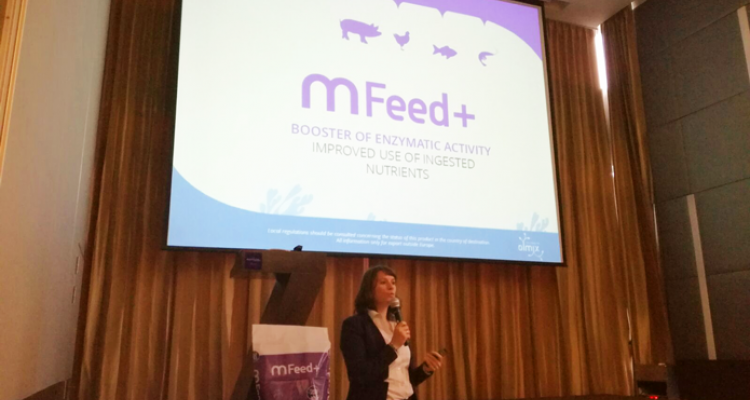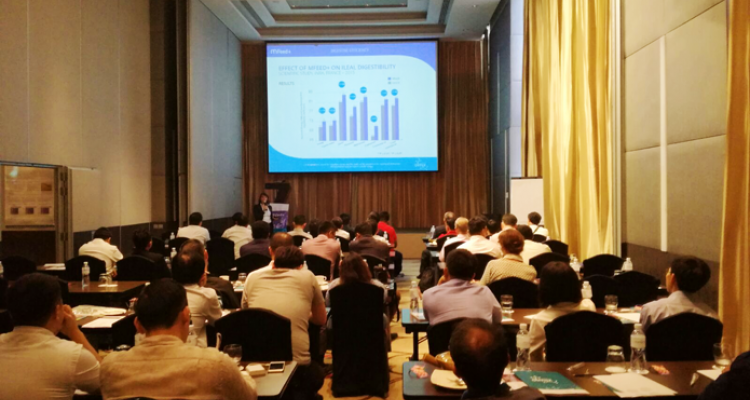The latest research, innovative techniques and production strategies on a more sustainable and respectful poultry farming were spotlighted at the Olmix APPC Satellite Seminar, the Olmix’s Symposium on Innovative and Practical Solutions in Poultry Production that was held at Novotel Bangkok Ploenchit Sukhumvit in Bangkok, Thailand, on March 24, prior to the Asian Pacific Poultry Conference.
Attended by dozens of poultry nutritionists, professionals and several representatives from the most prestigious companies in Asia, the scientific seminar counted on the presence of renowned world poultry experts, who brought topics such as DIGESTIVE EFFICIENCY or MYCOTOXIN RISK up for discussion.
After a warm welcome speech by Dr Niki Atienza, Olmix Asia Commercial Director, the conference programme opened with a keynote address by Prof. Carlos A. Mallmann, from Laboratory of Mycotoxicological Analysis (LAMIC) at Santa Maria University (Brazil), discussing the main diagnoses and strategies concerning mycotoxin risk management.
Besides introducing the complexity of assessing mycotoxin risk and the impact of mycotoxins on the animals’ zootechnical performance and metabolism:
"Aflatoxin is the most carcinogenic substance that you can find in nature for humans. As for animals, it dramatically reduces immunity and affects protein synthesis. We can say that the younger, the more sensitive animals are to mycotoxins. Genetics play a very important role when it comes to mycotoxin sensitivity. Fumonisins can damage the animal's brain, lung and liver. In worst cases they can even lead up to death", he explained.
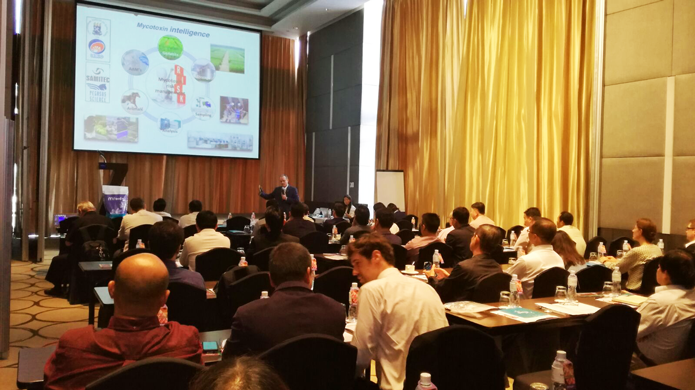
Prof. Mallmann at the Olmix Satellite Seminar.
As it could not be otherwise, the expert also highlighted on the global worrying issue of the natural co-occurrence of mycotoxins in foods and feeds, and the need to use advanced technology to analyse mycotoxins carefully.
"Masked Fumonisin is very common in raw materials and it is not analysed routinely so we underestimate contamination. Co-occurrence of mycotoxins is the rule, and they have synergistic effects, especially when found at low dosages. Mycotoxin risk algorithm is very complex, as many parameters influence it, including genetics, environmental factors, health status… In vivo evaluation of toxin binders is compulsory as there is few correlation of effect with in vitro results".
Following Prof. Mallman’s presentation, Dr Tran Si-Trung, from the Olmix’s Technical Service, took up the torch to present the tools and strategies that the company has come up with through deep research to cope with all challenges associated with mycotoxin risk management.
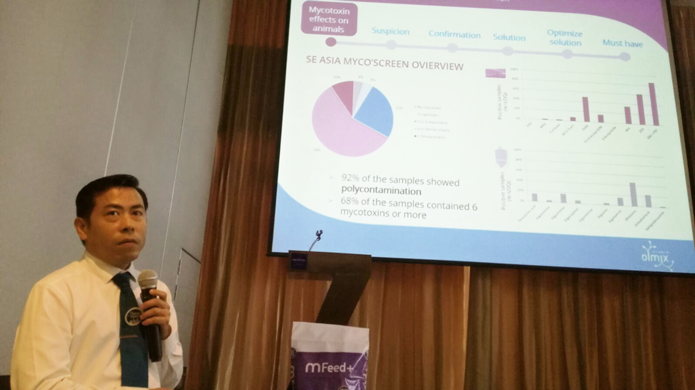
Dr Tran Si-Trung at the Olmix Satellite Seminar.
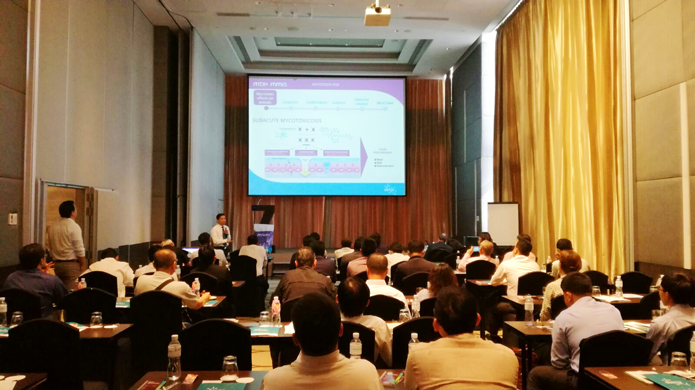
Dr Tran Si-Trung at the Olmix Satellite Seminar.
“Olmix provides a full set of tools and solution to help feed-millers, nutritionists and farmers to optimize mycotoxin management in the feed : it goes from online and offline tools such as the Olmix Myco'Evaluator to evaluate the risk and impact of mycotoxins in the farm, adapted to pigs, poultry and ruminants; the Myco’Screen, aiming at optimizing mycotoxin analysis strategy for feedingstuffs thatis composed of 4 sections: sampling procedure, mycotoxins analysis, personalized reports and contamination overview that give practical and realistic information to evaluate the encountered mycotoxin risk. Finally, the Myco’Calculator in order to optimize the use of toxin binder to each field situation.
Talking about Olmix technology, our mycotoxin binders MT.X+ and MMi.S effectively reduce the presence of complex toxins, hard-to-adsorb mycotoxins, such as deoxynivalenol or fumonisins. By using an interspersed clay, comprising clay and a specific algae extract, it is possible to open the structure of the clay to reach up to 10 times more the interlayer space. That allows to sharply increase the mycotoxin binding capacity”, Dr Si-Trung said.
By-products and digestive efficiency
If methods to control and prevent mycotoxins have proven to be very productive and profitable for producers and farmers, it can be said that by-products also play their role to improve the animals’ performance in the farm. That was, in fact, what Dr Ariel Carlos, Consultant from the Philippines, focused his presentation on at the third scientific lecture of the day:
“The ability to understand and manage by-products will determine the competitiveness and profitability of any feed or livestock business. Therefore, we should always take their limitations into account; that includes ‘palatability’, ‘mold and mycotoxins contents’ and ‘low digestibility’.
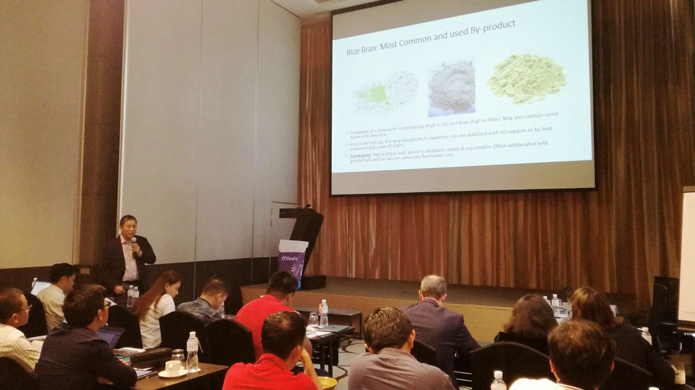
Dr Ariel Carlos at the Olmix Satellite Seminar.
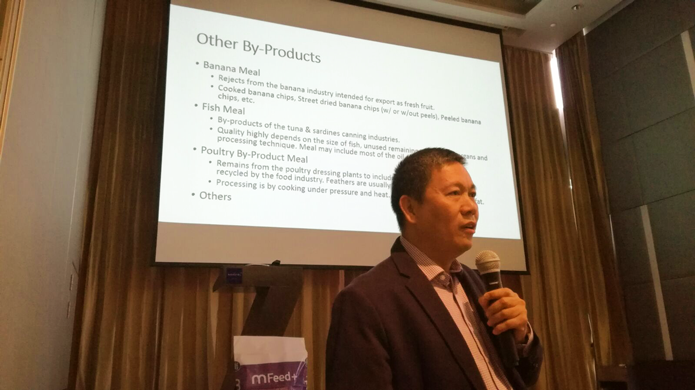
Dr Ariel Carlos at the Olmix Satellite Seminar.
Last, but not least, Ms Marie Gallissot, Olmix Group's Digestive Efficiency Product Specialist, went on stage to shine a spotlight on those strategies that can be applied to boost digestive enzymes and, in consequence, boost digestion and get better zootechnical results:
The event was closed by Mr Hervé Balusson, Olmix Group’s CEO & President, who took the opportunity to share a few words on the Olmix’s future steps to continue “providing solutions to grow together through challenging situations Thanks to Algae!”.






